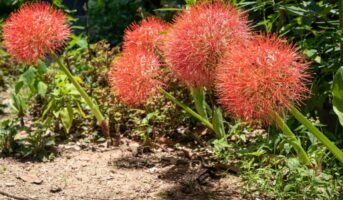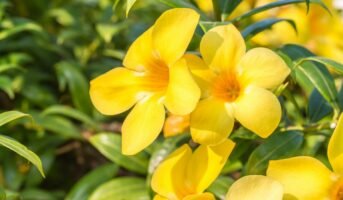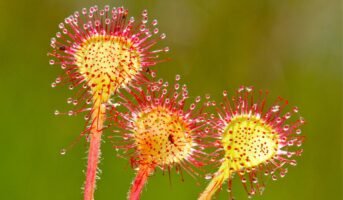Snapdragon is another name for the flower known as ‘dog flower’ in India. The common name “snapdragon” comes from how the flowers respond when their throats are squeezed, causing the flower’s “mouth” to open in the manner of a dragon’s mouth.
Dog flowers are frequently used as cut flowers as well as ornamental plants. There are dog flowers in every colour but blue. They have asymmetrical petals, stamens and stigma enclosed between the two petal lips that make up fused petals and are zygomorphic, according to botanical terminology.

Source: Pinterest
See also: About ornamental plants
Dog flower: Key facts
| Botanical name | Dog flower |
| Type | A small shrub |
| Leaf colour | Green |
| Flower | No |
| Also known as | Snapdragon |
| Season | Entire year |
| Sun exposure | Keep in shade with a few hours of direct sunlight |
| Ideal temperature | 70 to 90 degrees Fahrenheit |
| Soil type | Well-drained |
| Soil pH | Slightly acidic to slightly alkaline |
| Basic requirements | Intermittent watering, indirect sunlight, home-made fertiliser |
| Ideal location for placement | Outdoor |
| Ideal season to grow | Summer |
| Maintenance | Low |
Know about: Snapdragon Flower
Dog flower: How to grow?
Plant seeds in a greenhouse or covered tray on a sunny verandah in the autumn or early spring. Thinly scatter seeds over the top of the compost, water, and then cover with a clear plastic bag. When seeds are big enough to handle, put them in pots and let them continue to grow in a protected area or cold frame. After the risk of frost has passed, plant them outside. Flowers will bloom early in May from early autumn sowings.

Source: Pinterest
Also check these eco garden ideas
Dog flower: Propagation
Dog flowers are an affordable option to buy as nursery seedlings and can be easily grown from seeds. If preferred, they can also be propagated from stem cuttings. Take a 2-inch section of stem below a leaf node from a healthy parent plant. Remove lower leaves and dip the cutting’s bottom in rooting hormone. Plant it in seed starter mix or potting soil, covering the pot with a plastic bag or dome for humidity. Once a strong root system forms, remove the cover and continue growing near a bright window or under artificial lighting. Transplant outside around the time of the last frost in your region.
Dog flower: Care tips
When caring for dog flowers, keep in mind the following conditions, which are preferred by these plants.
Dog flower: Sunlight requirement
Dog flowers thrive in partial shade to full sun. Once the temperatures rise, they can stop blooming. Try to plant them in full shade and keep them watered well to help them make it through summers and bloom again in autumn.
Dog flower: Soil requirement
Dog flowers prefer neutral soil with a pH level between 6.2 and 7. Make sure the soil around your dog flower is rich in nutrients and well-draining. Being short-lived plants, dog flowers are not very heavy feeders. However, adding organic matter can help in keeping them blooming and healthy.
Dog flower: Water requirement
Dog flowers need moderate watering. It’s advisable to keep the seedlings moist for the initial few weeks on planting. Once they have established a root system, give them one inch of water every week during days of no rainfall. Avoid overhead watering and water the crown of the plant to keep your snapdragon healthy. Let the top inch of soil dry before watering again.
Dog flower: Temperature and humidity requirement
Dog flowers are hardy perennials that prefer cooler temperatures and thrive best when daytime temperatures are in the low 70s F and nighttime temperatures are around the low 40s F. This is why they are typically grown as annuals in the cooler months of fall and spring. Once established, dog flowers can tolerate sub-freezing temperatures. If you want your dog flower to survive cold temperatures, make sure they are watered well and add some pine straw mulch.
Dog flower: Fertiliser requirement
Apply fertiliser when your dog flower starts blooming. Choose a standard, well-balanced all-purpose fertiliser like a 10-10-10 product. Water the plant well to prevent nitrogen burn and help the fertiliser reach the roots.
Dog flower: Pests and diseases
Rust fungus is a major problem faced by dog flowers. If you witness rust on your plants, consider planting dog flowers in another part of your garden the next time. Dog flowers are also prone to fungal leaf spots, mould, root rot, wilt and downy mildew. Additionally, spider mites and aphids are the common pest problems suffered by do flowers. This can require the use of horticultural oils or pesticides.
How to get Dog Flower to bloom?
Do flowers are renowned for their vibrant blooms, starting in early spring and continuing throughout the season. They are considered short-lived perennials that often behave like annuals, typically blooming for just one season.
The key to successful Dog flower blooms lies in providing the right amount of sunlight. They thrive in a range of conditions, from full sun to partial shade. Adjusting the sun exposure will ensure healthy growth. Regular deadheading of fading flowers encourages abundant and continuous blooming of the plant.
Dog flower: Uses
- In addition to cultivating the plants for cut flowers, people have used the seeds to extract culinary oils, notably in Russia.
- The blooms have also been used to make a green dye.
- Due to its easy cultivation, diploid inheritance, and variety in shape and blossom colour, it became a model organism in early studies of heredity and mutation. However, it has historically been used as a diuretic, to treat tumours, scurvy, liver issues, and liver diseases, as well as a detergent and astringent.
- The flowers and leaves were employed as stimulants, resolvents, and antiphlogistics.
FAQs
In which colours are Dog flowers found?
Dog flowers are available in every colour except blue.
Are snapdragons available in India?
Snapdragons have adapted to life in India after being native to North Africa, Spain, and Italy.
Housing News Desk is the news desk of leading online real estate portal, Housing.com. Housing News Desk focuses on a variety of topics such as real estate laws, taxes, current news, property trends, home loans, rentals, décor, green homes, home improvement, etc. The main objective of the news desk, is to cover the real estate sector from the perspective of providing information that is useful to the end-user.
Facebook: https://www.facebook.com/housing.com/
Twitter: https://twitter.com/Housing
Email: [email protected]












